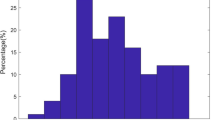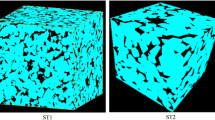Abstract
In order to further expand the understanding of the pore-throat structure of sandstone, a new method is proposed in this paper to reconstruct three-dimensional (3D) virtual sandstone and replicate the natural sandstone pore-throat structure. While reconstructing 3D virtual sandstone, a particle distribution factor M and a dilation filter D were introduced into the site percolation model. The function of M was to control the initial size of the solid particle while ensuring the randomness of the shape of the solid particle, whereas D gave acceptable deformation of the pore-throat structure while changing the porosity (P) of the 3D virtual sandstone. It was found that the virtual sandstone with high similarity to the real sandstone could be reconstructed by changing the combination of M and D regardless of the P, tortuosity, and pore coordination number of the real sandstone. The percolation thresholds of 3D virtual sandstone generated under different M and D were obtained, and the pore connectivity and permeability changes with M, D, and P were also investigated. The proposed method for virtual sandstone generation in this paper provides a novel approach for assessing and predicting the connectivity and permeability of sandstone reservoirs in oil and gas exploration.















Similar content being viewed by others
References
Bultreys, T., De Boever, W., & Cnudde, V. (2016). Imaging and image-based fluid transport modeling at the pore scale in geological materials: A practical introduction to the current state-of-the-art. Earth-Science Reviews, 155, 93–128.
Caulk, R. A., Ghazanfari, E., Perdrial, J. N., & Perdrial, N. (2016). Experimental investigation of fracture aperture and permeability change within Enhanced Geothermal Systems. Geothermics, 62, 12–21.
Colombier, M., Wadsworth, F. B., Gurioli, L., Scheu, B., Kueppers, U., Di Muro, A., & Dingwell, D. B. (2017). The evolution of pore connectivity in volcanic rocks. Earth and Planetary Science Letters, 462, 99–109.
Colombier, M., Vasseur, J., Houghton, B. F., Cáceres, F., Scheu, B., Kueppers, U., et al. (2021). Degassing and gas percolation in basaltic magmas. Earth and Planetary Science Letters, 573, 117134.
Cornette, V., Ramirez-Pastor, A. J., & Nieto, F. (2003). Percolation of polyatomic species on a square lattice. European Physical Journal B, 36, 391–399.
Cornette, V., Ramirez-Pastor, A. J., & Nieto, F. (2006). Percolation of polyatomic species with the presence of impurities. Journal of Chemical Physics, 125, 204702.
Daïan, J. F., Fernandes, C. P., Philippi, P. C., & da Cunha Neto, J. A. B. (2004). 3D reconstitution of porous media from image processing data using a multiscale percolation system. Journal of Petroleum Science and Engineering, 42(1), 15–28.
Dehghanpoor Abyaneh, S., Wong, H. S., & Buenfeld, N. R. (2013). Modelling the diffusivity of mortar and concrete using a three-dimensional mesostructure with several aggregate shapes. Computational Materials Science, 78, 63–73.
Du Plessis, J. P. (1999). Introducing a percolation threshold in pore-scale modelling. Physics and Chemistry of the Earth, Part A: Solid Earth and Geodesy, 24(7), 617–620.
Durrett, R. T. (1984). Percolation theory for mathematicians (Harry Kesten). SIAM Review, 26, 446–448. https://doi.org/10.1137/1026095
Fu, J., Thomas, H. R., & Li, C. (2021). Tortuosity of porous media: Image analysis and physical simulation. Earth-Science Reviews, 212, 103439.
Garboczi, E. J., & Bentz, D. P. (1995). Percolation phenomena by computer simulation. United States. https://www.osti.gov/biblio/214888
Garboczi, E. J., & Bentz, D. P. (2000). Percolation aspects of cement paste and concrete-properties and durability. In American Concrete Institute, ACI Special Publication (Vol. SP-189). https://doi.org/10.14359/5851
González, M. I., Centres, P., Lebrecht, W., Ramirez-Pastor, A. J., & Nieto, F. (2013). Site-bond percolation on triangular lattices: Monte Carlo simulation and analytical approach. Physica A: Statistical Mechanics and its Applications, 392(24), 6330–6340.
Guo, P., Gu, J., Su, Y., Wang, J., & Ding, Z. (2021). Effect of cyclic wetting–drying on tensile mechanical behavior and microstructure of clay-bearing sandstone. International Journal of Coal Science and Technology, 8(5), 956–968.
Hellemans, J., Forrez, P., & De Wilde, R. (1980). Experiment illustrating Bernoulli’s equation and Hagen–Poiseuille’s law. American Journal of Physics, 48(3), 12154.
Kallikragas, D. T., & Svishchev, I. M. (2019). Percolation transitions of physically and hydrogen bonded clusters in supercritical water. Journal of Molecular Liquids, 290, 111213.
Kang, Z., Wang, W., Zhao, Y., Liang, W., Yang, D., Zhao, J., & Zhao, D. (2014). Three-dimensional percolation mechanism in oil shale under different temperatures based on micro-CT. Yanshilixue Yu Gongcheng Xuebao/Chinese Journal of Rock Mechanics and Engineering, 33(9), 1837–1842.
King, P. R., & Masihi, M. (2018). Percolation theory in reservoir engineering. https://doi.org/10.1142/q0154
Kurzawski, Ł, & Malarz, K. (2012). Simple Cubic Random-Site Percolation Thresholds for Complex Neighbourhoods. Reports on Mathematical Physics, 70(2), 163–169.
Latief, F. D. E., Biswal, B., Fauzi, U., & Hilfer, R. (2010). Continuum reconstruction of the pore scale microstructure for Fontainebleau sandstone. Physica A: Statistical Mechanics and its Applications, 389(8), 1607–1618.
Lin, J., & Chen, H. (2018). Effect of particle morphologies on the percolation of particulate porous media: A study of superballs. Powder Technology, 335, 388–400.
Lin, J., Chen, H., & Liu, L. (2020). Impact of polydispersity of particle shape and size on percolation threshold of 3D particulate media composed of penetrable superellipsoids. Powder Technology, 360, 944–955.
Liu, J., & Regenauer-Lieb, K. (2011). Application of percolation theory to microtomography of structured media: Percolation threshold, critical exponents, and upscaling. Physical Review E: Statistical, Nonlinear, and Soft Matter Physics, 83(1), 016106.
Liu, J., & Regenauer-Lieb, K. (2021). Application of percolation theory to microtomography of rocks. Earth-Science Reviews, 214, 103519.
Liu, B., Zhao, Y., Zhang, C., Zhou, J., Li, Y., & Sun, Z. (2021). Characteristic strength and acoustic emission properties of weakly cemented sandstone at different depths under uniaxial compression. International Journal of Coal Science and Technology, 8(6), 1288–1301.
Liu, G., Xie, S., Tian, W., Wang, J., Li, S., Wang, Y., & Yang, D. (2022a). Effect of pore-throat structure on gas-water seepage behaviour in a tight sandstone gas reservoir. Fuel, 310, 121901.
Liu, J., Li, L., Zhang, C., Jiang, Y., Swennen, R., Zhao, C., & Hou, S. (2022b). Identification and quantitative evaluation of pores and throats of a tight sandstone reservoir (Upper Triassic Xujiahe Formation, Sichuan Basin, China). Marine and Petroleum Geology, 140, 105663.
Liu, J., Zhang, C., Jiang, Y., & Hou, S. (2022c). Investigation on pore structure characteristics of ultra-tight sandstone reservoirs in the upper Triassic Xujiahe Formation of the northern Sichuan Basin, China. Marine and Petroleum Geology, 138, 105552.
Liu, P., Nie, B., Zhao, Z., Zhao, Y., & Li, Q. (2023). Characterization of ultrasonic induced damage on multi-scale pore/fracture in coal using gas sorption and μ-CT 3D reconstruction. Fuel, 332, 126178.
Mostaghimi, P., Blunt, M. J., & Bijeljic, B. (2013). Computations of absolute permeability on micro-CT images. Mathematical Geosciences, 45, 103–125.
Pasinetti, P. M., Centres, P. M., & Ramirez-Pastor, A. J. (2019). Jamming and percolation of k 2-mers on simple cubic lattices. Journal of Statistical Mechanics: Theory and Experiment, 2019(10), 103204.
Payton, R. L., Chiarella, D., & Kingdon, A. (2022). The upper percolation threshold and porosity-permeability relationship in sandstone reservoirs using digital image analysis. Scientific Reports, 12(1), 1–15.
Pervago, E., Mousatov, A., Kazatchenko, E., & Markov, M. (2018). Computation of continuum percolation threshold for pore systems composed of vugs and fractures. Computers and Geosciences, 116(October 2017), 53–63.
Reviews, A., Leonard, J., & Poiseuille, M. (1953). The history of Poiseuille’s law. Annual Review of Fluid Mechanics, 25, 1–19.
Revil, A., Kessouri, P., & Torres-Verdín, C. (2014). Electrical conductivity, induced polarization, and permeability of the Fontainebleau sandstone. Geophysics, 79(5), D301–D318.
Rostron, B. J. (2018). Multiphase flow in permeable media. A pore-scale perspective. Groundwater. https://doi.org/10.1111/gwat.12812
Sakhaee-Pour, A., & Agrawal, A. (2018). Integrating acoustic emission into percolation theory to predict permeability enhancement. Journal of Petroleum Science and Engineering, 160(July 2017), 152–159.
Sanderson, D. J., & Nixon, C. W. (2018). Topology, connectivity and percolation in fracture networks. Journal of Structural Geology, 115, 167–177.
Siavashi, J., Najafi, A., Ebadi, M., & Sharifi, M. (2022). A CNN-based approach for upscaling multiphase flow in digital sandstones. Fuel, 308, 122047.
Stauffer, D., & Aharony, A. (2018). Introduction to percolation theory. Introduction To Percolation Theory. https://doi.org/10.1201/9781315274386
Swanson, S. K., Bahr, J. M., Bradbury, K. R., & Anderson, K. M. (2006). Evidence for preferential flow through sandstone aquifers in Southern Wisconsin. Sedimentary Geology, 184(3–4), 331–342.
Tavagh-Mohammadi, B., Masihi, M., & Ganjeh-Ghazvini, M. (2016). Point-to-point connectivity prediction in porous media using percolation theory. Physica A: Statistical Mechanics and its Applications, 460, 304–313.
Wang, F., Liu, Y., Hu, C., Wang, Y., Shen, A., & Liang, S. (2018). Experimental study on feasibility of enhanced gas recovery through CO2 flooding in tight sandstone gas reservoirs. Processes, 6(11), 214.
Wierman, J. C. (2003). Pairs of graphs with site and bond percolation critical probabilities in opposite orders. Discrete Applied Mathematics, 129(2–3), 545–548.
Wu, H., Ju, Y., Han, X., Ren, Z., Sun, Y., Zhang, Y., & Han, T. (2022). Size effects in the uniaxial compressive properties of 3D printed models of rocks: an experimental investigation. International Journal of Coal Science and Technology, 9(1), 83.
Xiao, D., Jiang, S., Thul, D., Lu, S., Zhang, L., & Li, B. (2018). Impacts of clay on pore structure, storage and percolation of tight sandstones from the Songliao Basin, China: Implications for genetic classification of tight sandstone reservoirs. Fuel, 211, 390–404.
Xu, W., & Jiao, Y. (2019). Theoretical framework for percolation threshold, tortuosity and transport properties of porous materials containing 3D non-spherical pores. International Journal of Engineering Science, 134, 31–46.
Xu, F., Xu, Z., & Yakobson, B. I. (2014). Site-percolation threshold of carbon nanotube fibers: Fast inspection of percolation with Markov stochastic theory. Physica A: Statistical Mechanics and its Applications, 407, 341–349.
Yang, C. H., Hsu, C. L., Chen, N. Y., & Shih, C. T. (2011). Temporal dynamics of site percolation in nanoparticle assemblies. Computer Physics Communications, 182(1), 71–73.
Yonezawa, F., Sakamoto, S., & Hori, M. (1989). Percolation in two-dimensional lattices. I. A technique for the estimation of thresholds. Physical Review B, 40(1), 636.
Zendehboudi, S., Rezaei, N., & Lohi, A. (2018). Applications of hybrid models in chemical, petroleum, and energy systems: A systematic review. Applied Energy, 228, 2539–2566.
Zhu, P., Lin, C., Ren, H., Zhao, Z., & Zhang, H. (2015). Micro-fracture characteristics of tight sandstone reservoirs and its evaluation by capillary pressure curves: A case study of Permian sandstones in Ordos Basin, China. Journal of Natural Gas Science and Engineering, 27, 90–97.
Acknowledgments
This work was supported by the National Key Research and Development Program of China (Grant Nos. 2019YFA0705501 and 2019YFA0705502), National Natural Science Foundation of China (Grant No. 52104128), Basic Research Program of Shanxi Province (Grant No. 20210302123177), Key R&D and Promotion Projects in Henan Province (Grant No. 212102310010)
Author information
Authors and Affiliations
Corresponding author
Ethics declarations
Conflict of Interest
The authors have no competing interests to declare, and no financial or non-financial interests to disclose.
Rights and permissions
Springer Nature or its licensor (e.g. a society or other partner) holds exclusive rights to this article under a publishing agreement with the author(s) or other rightsholder(s); author self-archiving of the accepted manuscript version of this article is solely governed by the terms of such publishing agreement and applicable law.
About this article
Cite this article
Huang, X., Zhao, J., Zhou, Z. et al. 3D Percolation Modeling for Connectivity and Permeability of Sandstone with Different Pore Distribution Characteristics. Nat Resour Res 33, 191–212 (2024). https://doi.org/10.1007/s11053-023-10277-2
Received:
Accepted:
Published:
Issue Date:
DOI: https://doi.org/10.1007/s11053-023-10277-2




